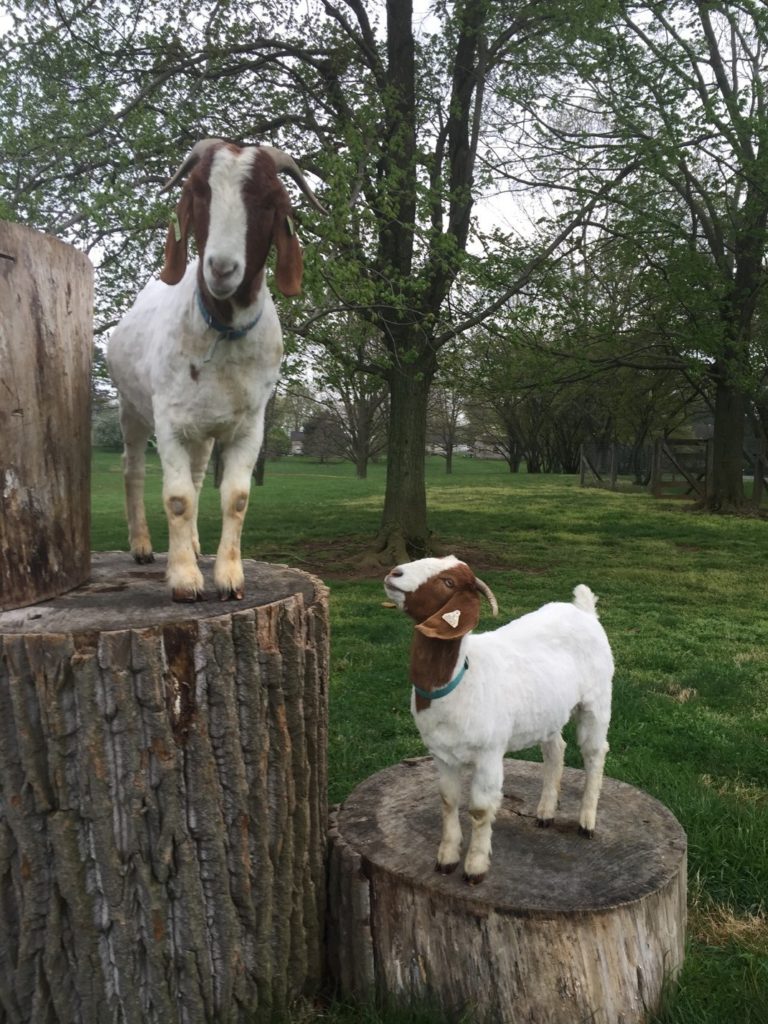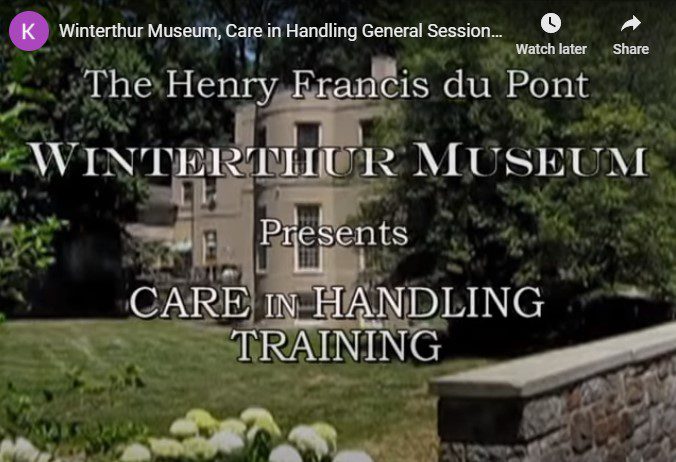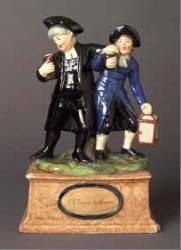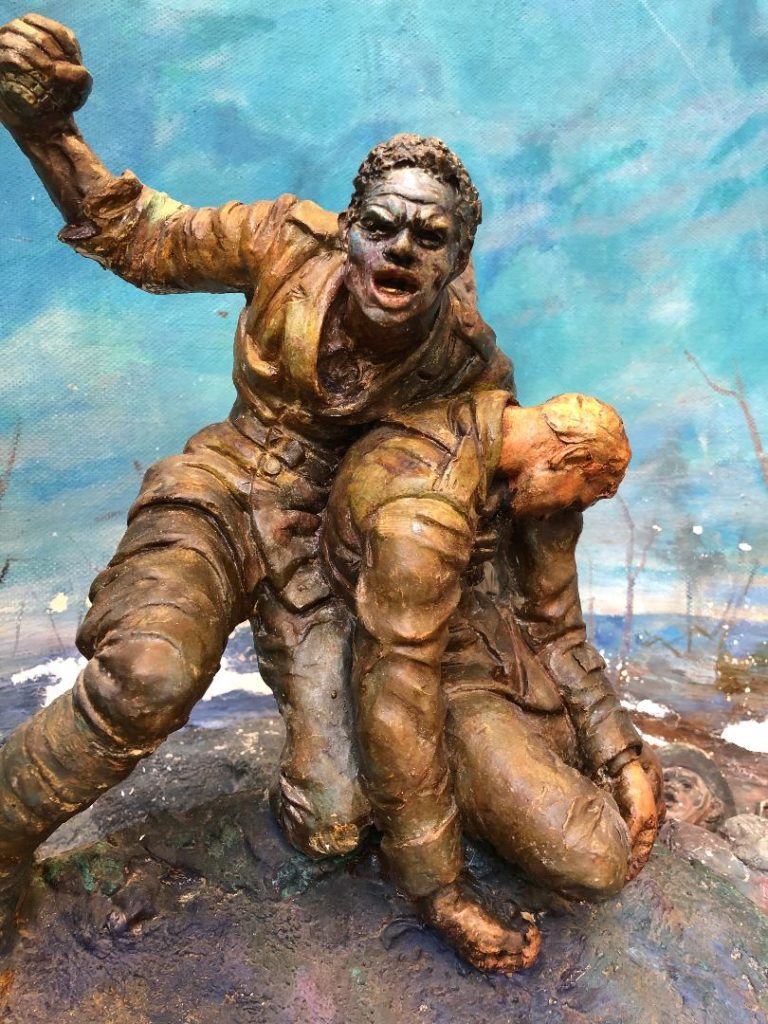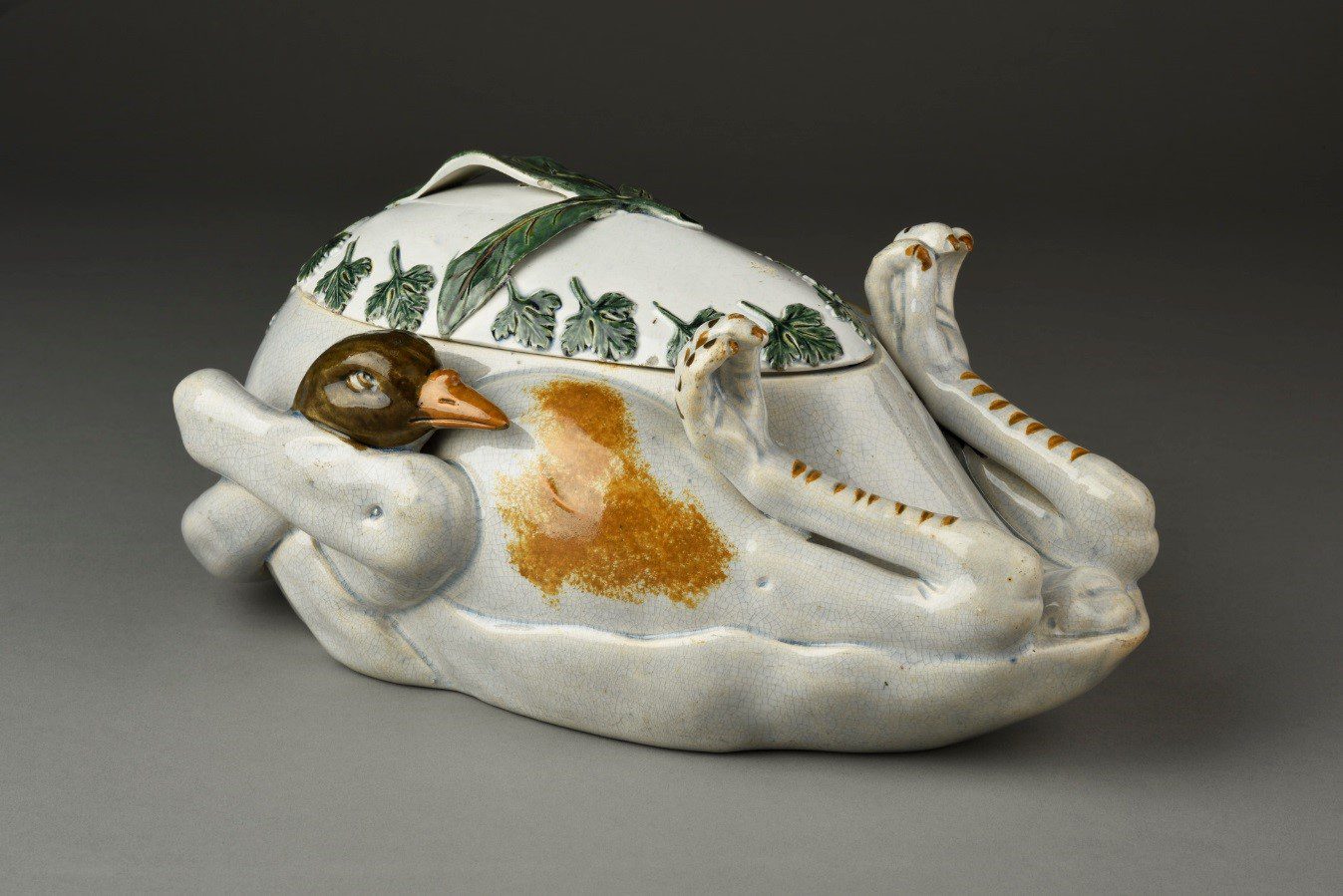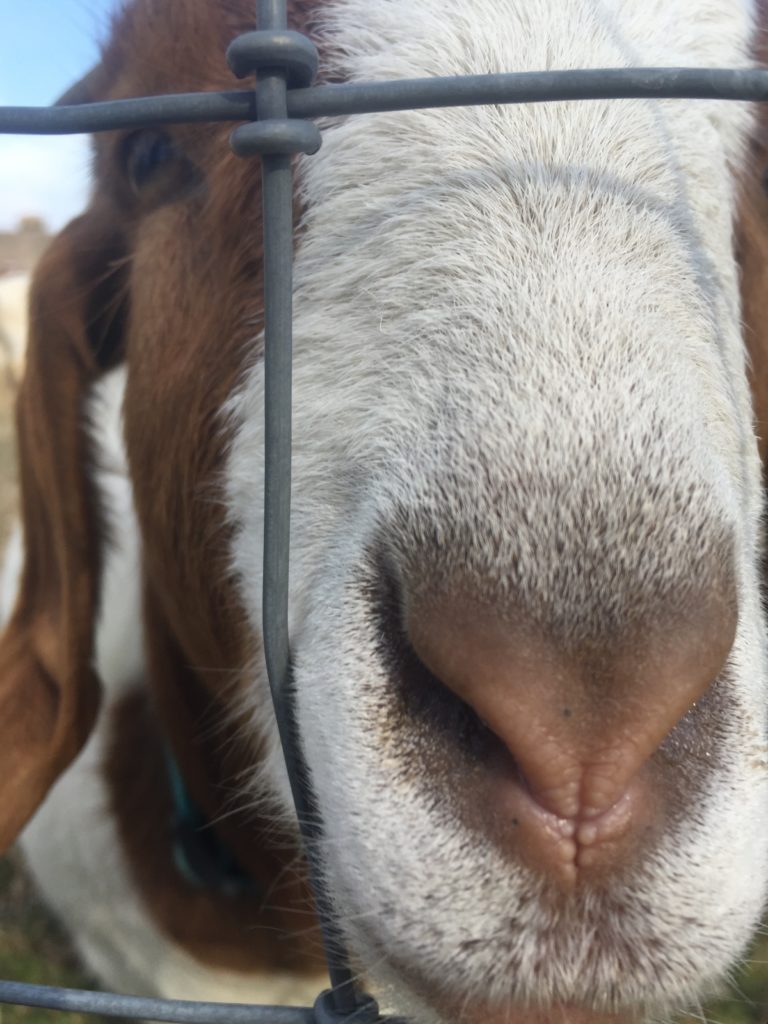Vicar and Moses figure group
Staffordshire, England; 1810
Earthenware (pearlware)
Height: 11.25″ (28.575 cm)
Width: 7.5″: (19.05 cm)
Depth: 4.563″ (11.59 cm)
Gift of Thomas N. and A. Pat Bernard
2002.30.84
Contact Information
General Information
| Phone800.448.3883302.888.4600302.888.4907 TTY | E-mailtourinfo@winterthur.org | |
Mailing AddressWinterthur Museum, Garden & Library 5105 Kennett Pike Wilmington, DE 19735 |
Departmental Directory
Historic African American Dioramas Are No Longer Forgotten
Resting atop a worktable in the Winterthur painting conservation lab is a 4-by-5-foot diorama that depicts three doughboys in the heat of battle during World War I. Two of the figures are Black. One throws a grenade as the other drags an injured white soldier out of harm’s way. The structure beautifully captures a powerful moment of heroism and the character of its subjects.
The 80-year-old diorama, World War I, is the last of 33 created for and displayed at the American Negro Exposition, a World’s Fair-style event, held in Chicago in 1940. The event was organized to celebrate 75 years of emancipation while promoting racial understanding, and was considered to be the first opportunity Black Americans had to tell their story to the world in their own way. The dioramas, displayed in the center of the Chicago Coliseum, depicted the contributions Africans and other peoples of African descent made to world events and culture since black slaves built the Great Sphinx of Giza 4,500 years ago.
World War I may be the last in the series of dioramas, but it is certainly not the end of the story. The 20 surviving dioramas, now in the collection of the Legacy Museum at Tuskegee University, represent almost all that remains to explain an important but almost forgotten event while introducing students of color to the profession of art conservation. Correspondent Rita Braver is scheduled to tell the story during the August 30 episode of “CBS Sunday Morning.”
Supervised by African American artist Charles C. Dawson, the dioramas were created by more than 120 African American artisans in Chicago in just three months of 1940. Beyond the dioramas, the only material records of the American Negro Exposition known to exist are some posters, guidebooks, and catalogues for Exhibition of the Art of the American Negro (1851-1940). About 250,000 people paid 25 cents each to visit during the 60-day run, but due to financial troubles and attendance numbers far short of the 2 million visitors the organizers hoped for, the exposition was considered a failure. But the dioramas still have much to teach.
World War I depicts the bravery of the U.S. Army’s 369th regiment at Meuse-Argonne. Known as the Harlem Hellfighters, the soldiers were especially feared by their German foes. The two standing figures are Needham Roberts and Henry Johnson, who were awarded the first two prix de guerre from the French for their bravery in charging the German lines to rescue their comrades.
The original subtitle to the diorama reads: “Over 380,000 Negro enlisted men and more than 1,500 Negro commissioned officers, with the rank from 2nd Lieutenants to Colonels, participated in this War. They were engaged in all offensives as combat troops and in other capacities. The highlight was the organization and participation as a unit of the first Negro combat division in American history, the 92nd or Buffalo Division. The first Americans to be honored in this war were two Negro Sergeants: Needham Roberts and Henry Johnson of the 369th Infantry Regiment. The most honored of all American regiments was the 369th Regiment of Infantry of New York.”
The diorama, like most of the 19 others delivered to the George Washington Carver Museum (now the Legacy Museum of Tuskegee University) soon after the exposition closed, was damaged in transport. Some were damaged by a fire a few years later, and all suffered from years of neglect in storage. They now offer learning opportunities for young conservators.
There is a critical need for conservators and curators of color. According to the Andrew W. Mellon Foundation, African Americans represent about only 1.5 percent of cultural-heritage professionals while Caucasians account for 85 percent. Barriers to entering the field of conservation are significant: There are only a few graduate programs in art conservation in the United States, and to be considered for admission, candidates need to have backgrounds in chemistry, art history, and studio art and ideally 400 hours in a conservation studio showing their patience, dexterity, and problem-solving abilities.
They can gain that experience through the Tuskegee Diorama project/HBCU Alliance of Museums and Galleries internship program. The initiative is headed by Dr. Jontyle Robinson, curator of the Legacy Museum at Tuskegee University who will be featured on the CBS segment, and Dr. Caryl McFarlane, executive consultant of the HBCU Alliance of Museums and Galleries. The pair formed the HBCU Alliance of Museums and Art Galleries in 2017 to promote diversity in the field of cultural heritage. They have been working since 2016 with Debbie Hess Norris, director of the Winterthur/University of Delaware (UD) Program in Art Conservation, and Dr. Joyce Hill Stoner, director of the UD Preservation Studies Doctoral Program and Winterthur’s adjunct paintings conservator. The Kress Foundation has supported the last three years of the diorama initiative.
The effort puts the future of Black history directly in the hands of African American students. As part of the program, Winterthur, the University of Delaware, and several other institutions, such as Yale University, have welcomed a small group of students each June since 2017 for an introduction to practical conservation (the program was delivered online during the Covid 19 pandemic this summer). The students learn by helping to remove grime, consolidate flaking plaster, and in-paint with reversible conservation retouching paints. They also research related topics and listen to presentations by Winterthur conservators in objects, textiles, books, photographs, furniture, works on paper, and preventive conservation.
When World War I arrived at Winterthur, a thick layer of dust and grime disguised its bright blue and red overall color scheme and the plaster ground was flaking. Johnson’s grenade arm had broken off; it arrived separately in a small box. Since January, other conservation interns have continued to consolidate the flaking paint and plaster, painstakingly removing decades of dust and dirt with small cosmetic sponges, correcting a repair made in 1945, and re-attaching Johnson’s arm. When finished in early 2021, the diorama will be returned to the Legacy Museum for display in the ongoing exhibition 20 Dioramas: Brightly-Lit Windows, Magically Different.
The first three dioramas that were treated at Winterthur depict the arrival of the first African slaves in Virginia in 1619, the shooting of Crispus Attucks in the Boston Massacre (the first death of the American Revolution) in 1770, and discovery of the North Pole in 1909 by explorer Matthew Henson accompanying Admiral Robert Peary. Scheduled to arrive next year is a diorama that depicts the towing of the Sphinx, which allows Winterthur and the University of Delaware the privilege of preserving the beginning and the end of the diorama stories as these objects move into their new future.
Look for more on CBS Sunday Morning on August 30.
Winterthur is further helping to train young conservators of color through the HBCU Library Alliance Preservation Internship Program, an eight-week, paid internship for seven students at seven different, nationally recognized library conservation labs. Each site contributes 50 percent of the cost for each intern, including travel, a stipend for living, and other support. Other participants in the program include Yale, Harvard, Duke, and the Library of Congress. That is tremendous support for young people from some of the most esteemed institutions in the country. It is coordinated by Winterthur library and archives conservator Melissa Tedone.
Winterthur Trails This Week – Armor Farm & Chandler Woods
 This week I chose another trail that takes you in and out of shaded woodland, with an opportunity to see one of our most striking meadows and an absolutely huge tulip poplar. Once again, I linked two trails – Armor Farm and Chandler Woods – to create a large, irregular figure-8 loop that is 2.6 miles long. I have outlined my walk below and provided a photo gallery (by the way, if you would like a PDF version of our hiking map follow this link www.winterthur.org/map). For those tech-savvy walkers I am providing a link to an AllTrails map below that allows you to follow the route with your smartphone. Happy hiking!
[ngg src=”galleries” ids=”126″ display=”basic_imagebrowser”]
This week I chose another trail that takes you in and out of shaded woodland, with an opportunity to see one of our most striking meadows and an absolutely huge tulip poplar. Once again, I linked two trails – Armor Farm and Chandler Woods – to create a large, irregular figure-8 loop that is 2.6 miles long. I have outlined my walk below and provided a photo gallery (by the way, if you would like a PDF version of our hiking map follow this link www.winterthur.org/map). For those tech-savvy walkers I am providing a link to an AllTrails map below that allows you to follow the route with your smartphone. Happy hiking!
[ngg src=”galleries” ids=”126″ display=”basic_imagebrowser”]

Garlic Mustard—Springtime’s Worst Offender
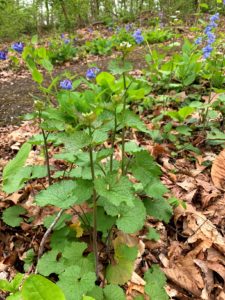
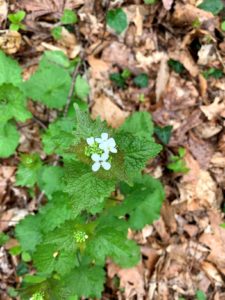
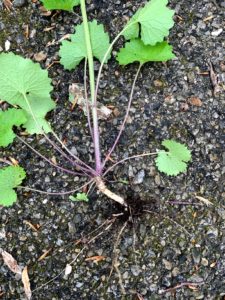
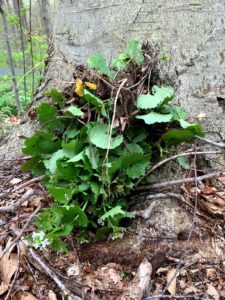
Silhouette Sleuthing: The Mystery of the Weston Profile Artist
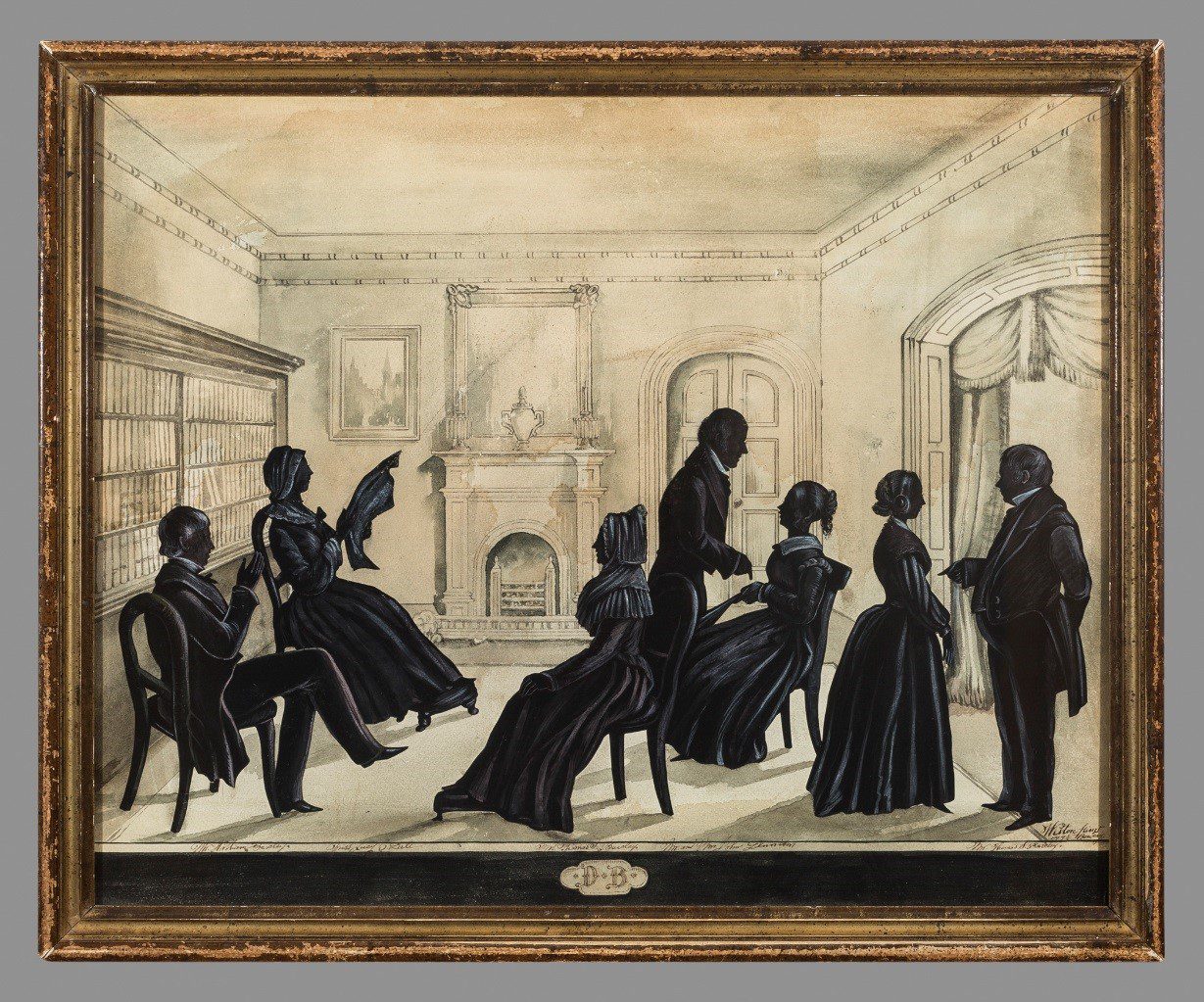
What started as simple research into a silhouette in the Winterthur collection progressed to a three-month trek through directories, census records, newspaper advertisements, maps, artist encyclopedias, archives, and auction catalogs. The silhouette in question, a group portrait against an interior in watercolor, has proved to be fascinating, and research has discounted previous scholarship as a new story emerges.
Silhouettes were popular and cheap forms of portraiture throughout the 18th century and into the 19th century. During the period, they were referred to as “shades” or “profile miniatures,” though by the early 19th century they are just described as “profiles.” (1) There are various ways to produce these profiles, though the most talented artists could cut freehand, such as the most prolific 19th-century silhouettist Auguste Édouart.(2) Originally from France, Édouart traveled extensively through Great Britain and America creating some 100,000 silhouettes, keeping a copy or record of each one he produced. Winterthur has some examples of Édouart’s work.
Other silhouettists could sketch from life or use a mechanical device like a physiognotrace to capture the profile.
While many silhouettes feature one figure, this piece contains seven cut silhouettes painted black with white and tinted highlights to delineate details on the clothing and accessories. Underneath these figures the viewer can read the names of the Dennison and Barcley family and a “Miss Lucy Dale.” In the bottom right corner, the silhouette is signed “Weston pinxt./ 149 ½ Bowery.” On the reverse of the frame, an affixed label also gives the address 149 ½ Bowery. Winterthur’s records cited Mary Bartlett Pillsbury Weston as the artist, though a letter in the records from 1957 indicated that no Weston had been found in the New York City Directory at the Bowery location in the 1840s. From here, the questions grew.
Conducting genealogical research on Mary Pillsbury Weston, I discovered a captivating tale of a woman determined to be an artist. Born in Hebron, New Hampshire, in 1817, she was the daughter of Baptist minister Stephen Pillsbury and Lavinia Hobart. Texts from the 19th century recount Mary Weston’s romantic tale: a deep yearning as a child to paint and how she ran away two times in an attempt to become an artist, finally moving to Willington, Connecticut, in 1837, painting portraits of local families. While in Connecticut, she met New Yorker Valentine Weston, brother to Willington citizen Jonathan Weston. Valentine invited Mary to come to New York, where he would employ artists to continue to instruct her and help her become an artist. After three months of living in New York, Mary married Valentine in 1840.(3) Mary Weston lived in New York until after her husband’s death in 1863.
Regardless of any tentative ties to Édouart, texts from the 19th century only claim that Mary was a portrait and landscape artist. There is no evidence that she ever made silhouettes and that is supported by archival research. The Kenneth Spencer Research Library at the University of Kansas holds the Pillsbury Family Papers, which contain Mary Weston’s outgoing letters from 1840 to 1867. While Mary wrote about painting and selling her work, she never mentions a silhouette business.
For most researchers, labels on objects are considered a gift. Other times, they only make the piece more confusing, as in the case of the Weston profile. Valentine Weston, 32 years Mary’s senior, appears in the New York City Directory as a blind maker, frame maker, and looking glass maker as early as 1822 and into the 1840s. His son from a previous marriage, John L. Weston, also owned a frame-making business in that same period continuing into the 1850s. Frame makers frequently sold prints and drawing in their store, thus it would not have been a leap to assume that Mary had a deal with her husband and son-in-law to create framed silhouettes for clients. However, at no point are these two men ever listed at 149 ½ Bowery, and their businesses stayed within the lower west side.
At this point, it seems unlikely that Mary Bartlett Pillsbury Weston ever made and sold silhouettes. Who was the Weston who created this silhouette? Who are the sitters? How do we know that this is even from the 1840s? These questions will continue to be pursued in part two, which will be posted on next week!
You can see this silhouette and others from the Winterthur Library and museum collection in the special loan exhibition In Fine Form: The Striking Silhouette at the Delaware Antiques Show, November 9–11, 2018.
Post by Amanda Hinckle, Robert and Elizabeth Owens Curatorial Fellow, Museum Collections Department, Winterthur Museum, Garden & Library
Winterthur is very grateful for funding from the National Endowment for the Arts, which has given us the ability to photograph and digitize works on paper in the collection, including these silhouettes.
(1) Emma Rutherford, Silhouette: The Art of the Shadow (New York: Rizzoli, 2009), 21.
(2) Rutherford, Silhouette, 29.
(3) E.F. Ellet, Women Artists in All Ages and Countries (New York: Harper & Brothers, 1859); H. W. French, Art and Artists in Connecticut (Boston: Lee and Shepard, Publishers; New York: Charles T. Dillingham, 1879); and Augusta Harvey Worthen, The History of Sutton, New Hampshire: Consisting of the Historical Collections of Erastus Wadleigh, Esq., and A. H. Worthen (Concord, NH: The Republican Press Association, 1890).
Looks Good Enough to Eat!
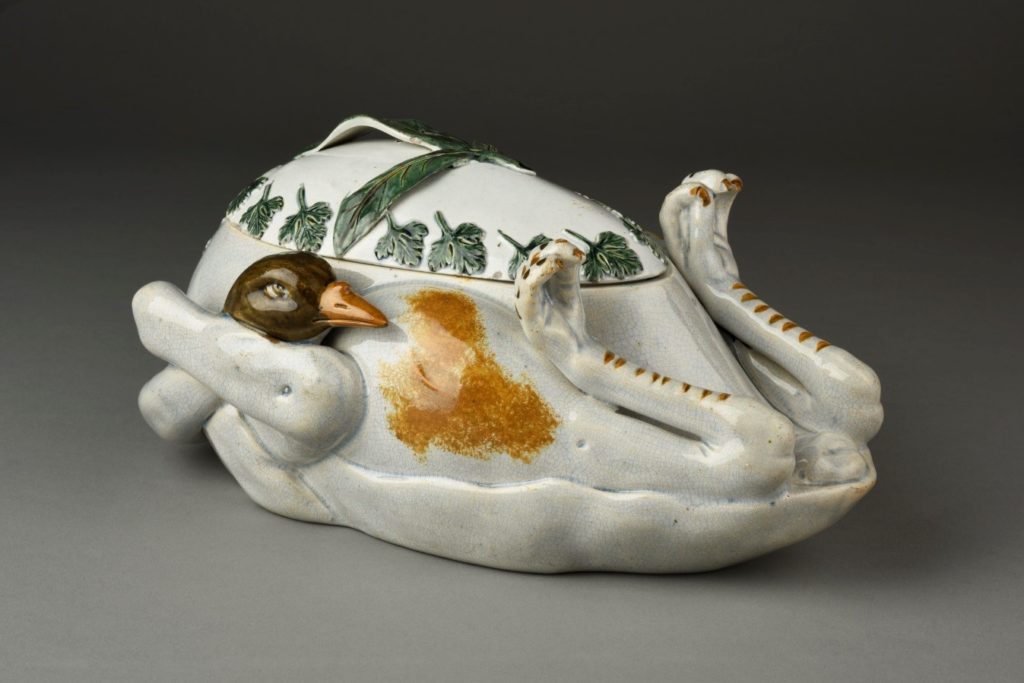
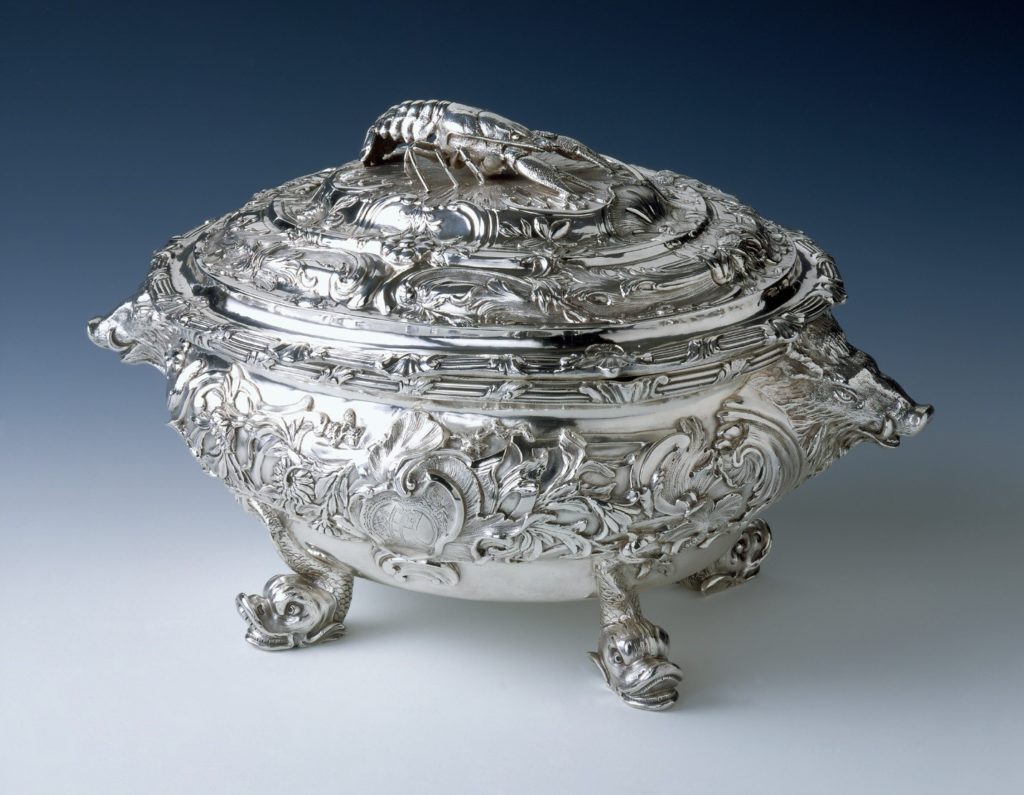
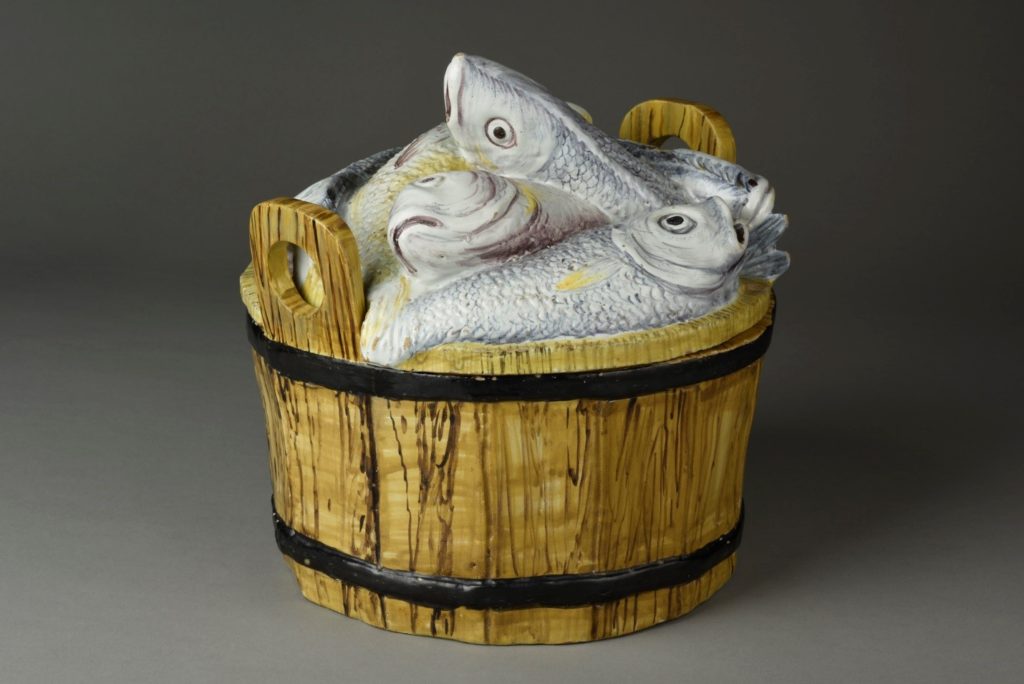
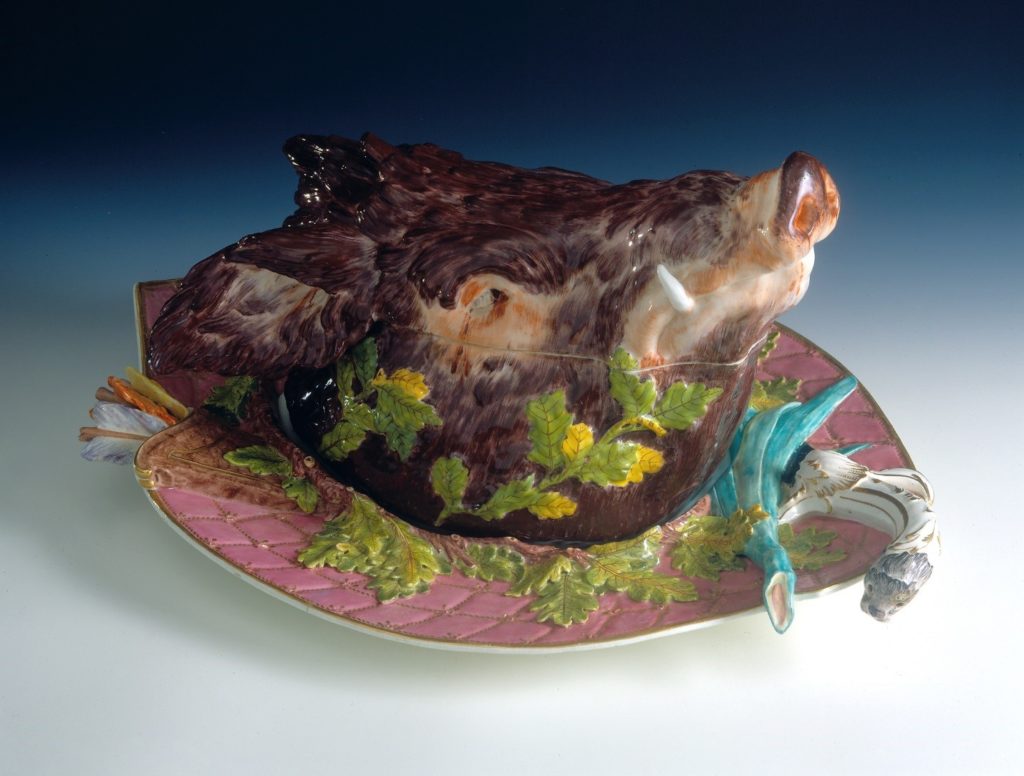
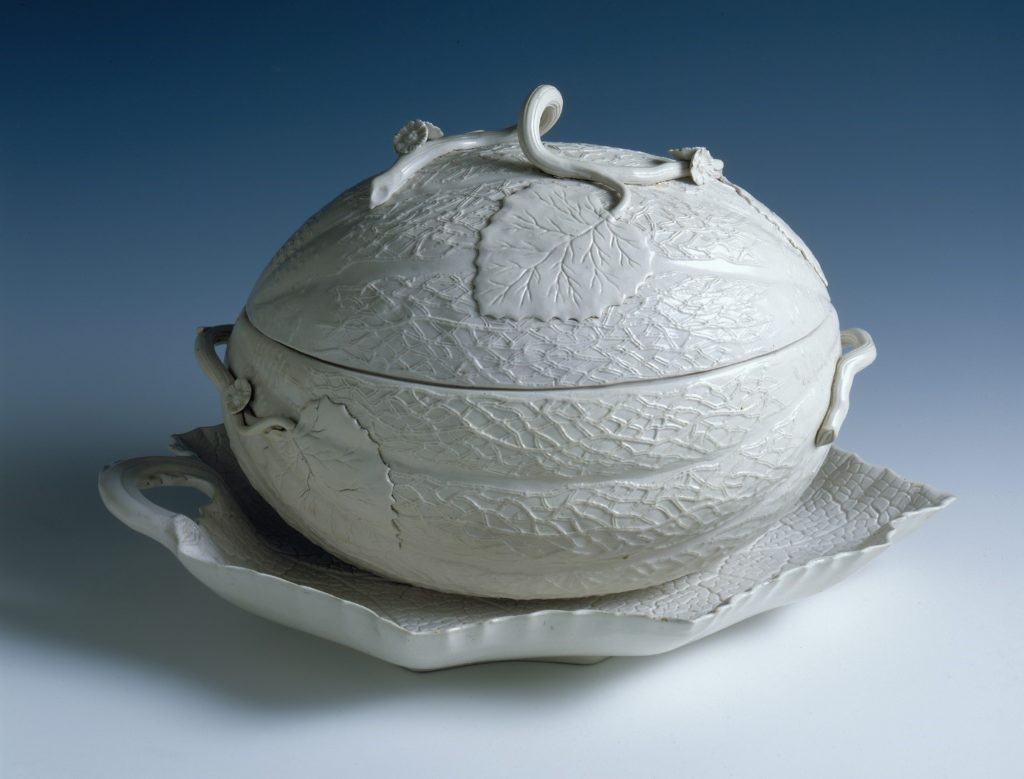
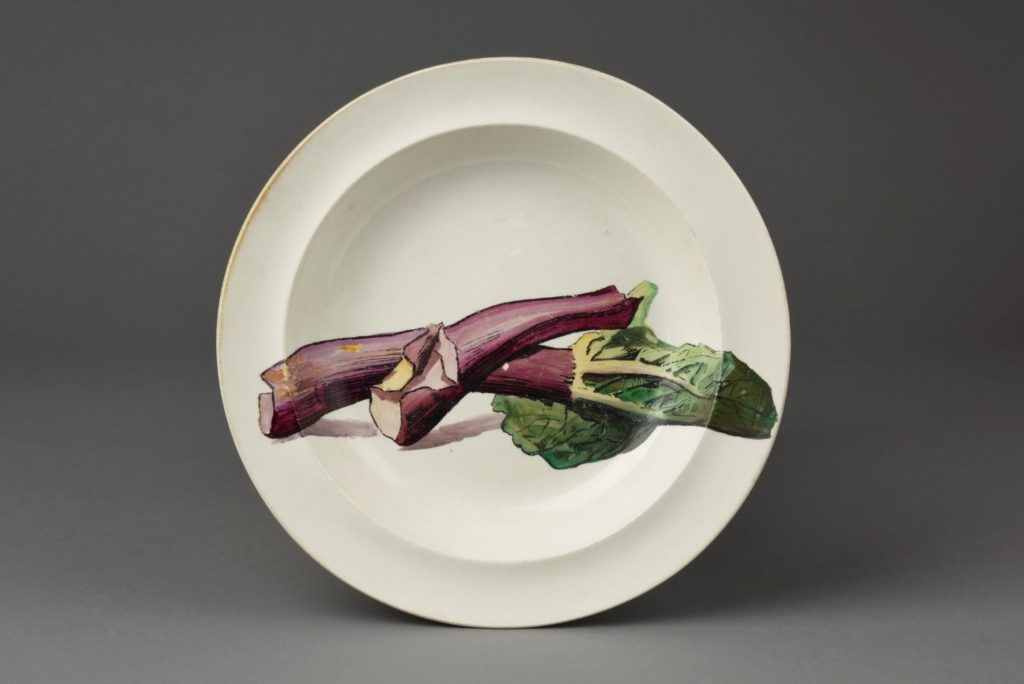
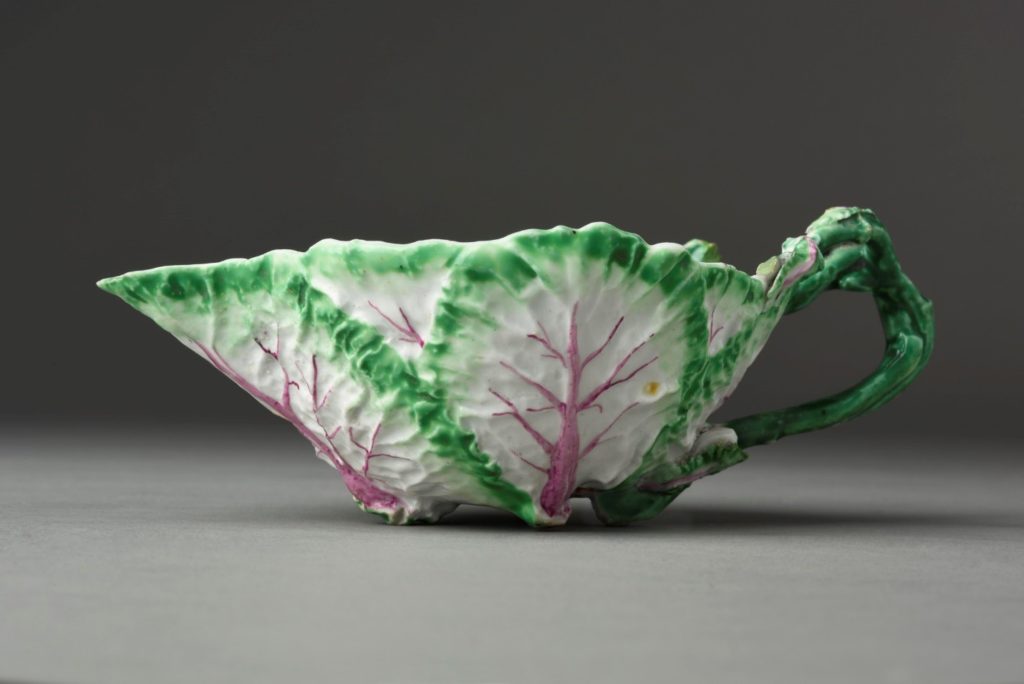
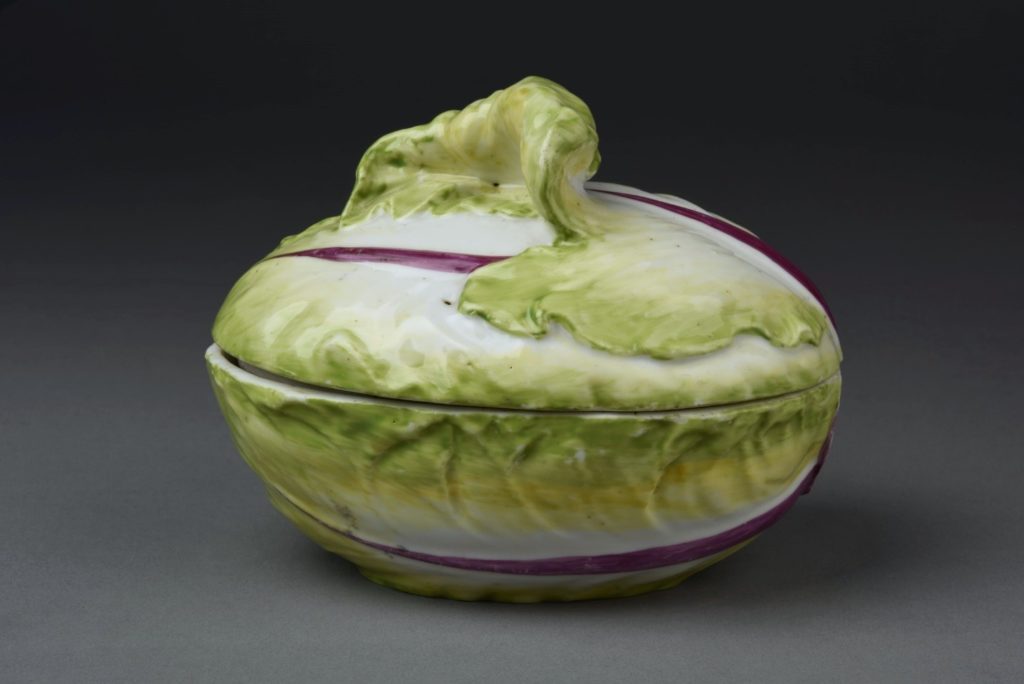
Silhouette Sleuthing: Solving the Mystery of the Weston Profile Artist (Part 2)
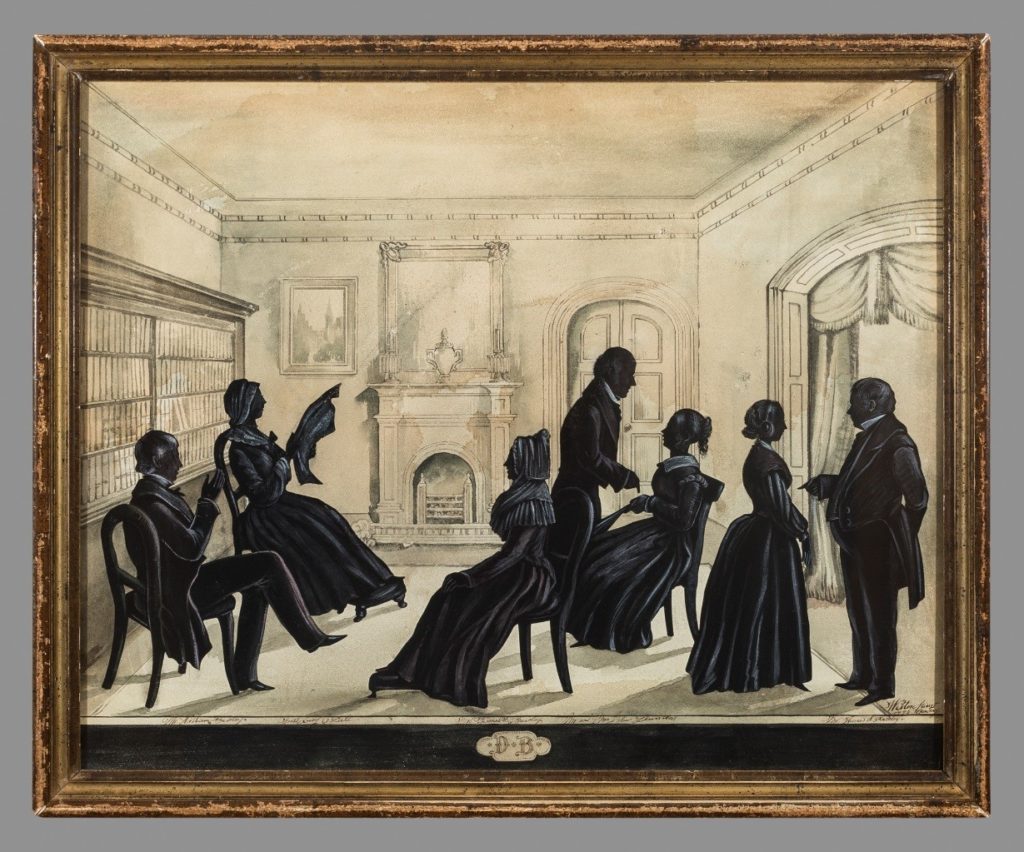
In the first Silhouette Sleuthing blog post, I detailed how I discovered that one of the silhouettes in the Winterthur collection had been misattributed to artist Mary Pillsbury Weston, who was most famous for her Spirit of Kansas painting exhibited at the Columbian Exhibition. There is no evidence to suggest that she ever produced and sold silhouettes. If the Weston profiles were not created by Mary, then who created them? I started to look through auction catalogs for other Weston silhouettes, hoping to understand the artist’s style. I found other pieces attributed to Weston, many of which are signed and contain the “Weston Profiles” label on the rear of the frame. Two types of signatures appear. The first, similar to the silhouette in the Winterthur collection, is a handwritten, cursive script with “Weston pinxt./149 ½ Bowery.” It can be found on a full-length silhouette of a woman, which was sold at auction by Northeast Auctions in 2015. (1) Other examples have a block-lettered serif signature “Weston of NY,” sometimes including the date. The two signatures could indicate that different individuals created these silhouettes under the name “Weston Profiles.”
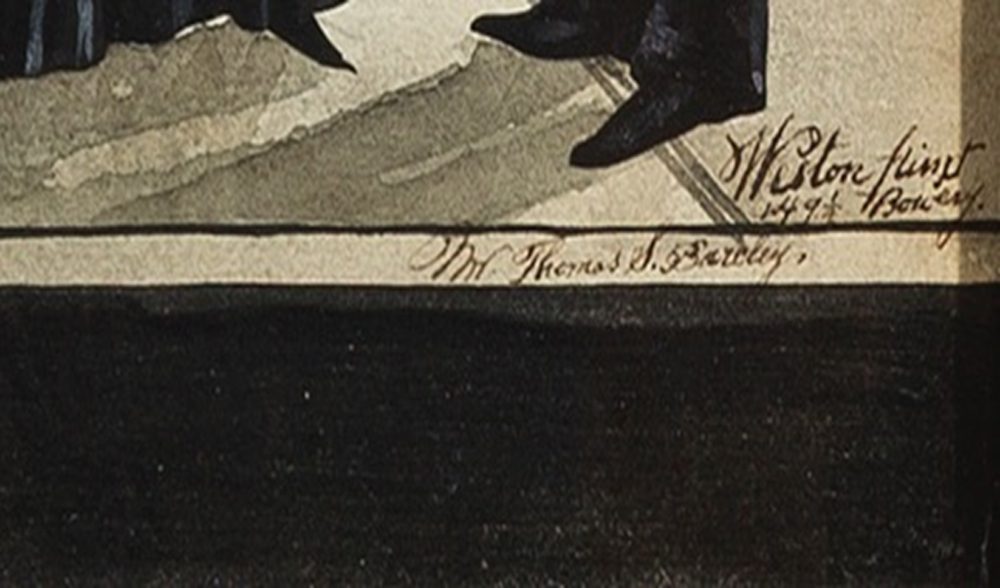
Since most of the silhouettes have a “Weston Profiles/149 ½ Bowery” label attached to the back of the frame, it indicates that they have a common source. However, this does not solve the mystery of the address, since no Westons have been found at 149 ½ Bowery, as discussed in the previous blog post. Could these silhouettes be fake? Winterthur Paper Conservator Joan Irving examined the Weston profile in the frame, and there were no red flags to suggest it was not produced in the 19th century. However, she did note that the label appeared to have been cut down at some point. This does not mean that the silhouette is fake, it is possible the piece was reframed at some point and the label reaffixed to the new frame.
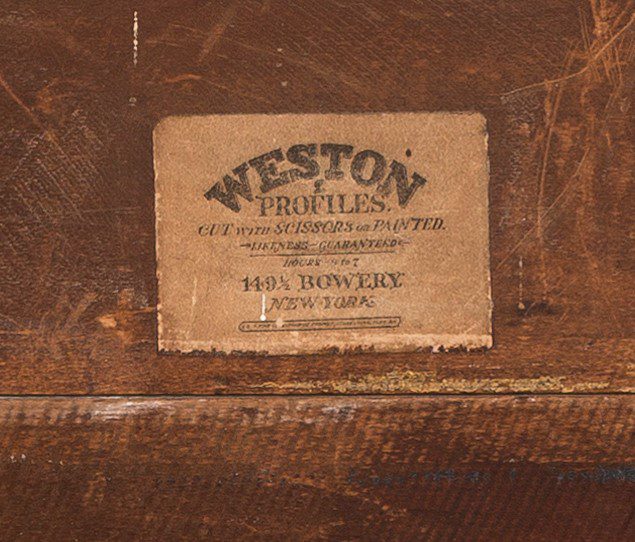
If we accept the material evidence that these silhouettes were made in the 1840s, and there are no known Westons living on Bowery at this time, who or what was at 149 ½ Bowery? The only reference to a 149 ½ Bowery found in primary sources is J. Wilson Fancy Goods Store listed in the New York Mercantile Union Business Directory in 1850. This reference seemed promising since a silhouettist could have operated out of a fancy goods store. J. Wilson, however, could not be traced to that location prior to 1850 in Trow’s New York City Directory. Looking at what businesses worked out of 149 Bowery during the 1840s, I found a distillery, leather working, and saddlery at this location. The leather business is possibly the closest connection, since cases for miniatures, silhouettes, and daguerreotypes typically utilized leather, and I found a group of Westons who operated a daguerreotype business in the city. This group of Westons can be found in the New York City directories during the period of production, and they include a John P. Weston, a Robert Weston, and another Mary A. Weston—all of whom were daguerreotypists. This was a promising avenue because the career jump from silhouettist to daguerreotypist would not have been surprising in the period. Silhouettes were a cheap, quick, and easy way to produce form of portraiture, some even employing the physiognotrace or pantograph machines, which are considered forerunners to photography. (2) Boundaries between what we understand as “fine artist” and “daguerreotypist” were fluid with some artists producing both artwork and daguerreotypes at the same time, and others using the technology to help with their artwork. Photography eclipsed silhouettes in the mid-19th century as a more accurate and equally easy method to produce mode of portraiture. According to the directories, James P. Weston operated in New York City as a daguerreotypist from 1842 to 1857. In 1842, James partnered with artist William Hendrik Franquinet to create a series of daguerreotype views of the city of New York and continued to work as a daguerreotypist throughout the 1840s and into the 50s. (3) Unfortunately, James P. Weston disappears from the records after 1857. The husband and wife pair, Robert and Mary A. Weston, were also in the daguerreotype business. The 1850 Federal census lists English-born Robert Weston as an artist, while the 1855 New York Census reports that he worked with daguerreotypes. (4) Mary’s profession is never listed in either census. Possibly blood relatives, Robert Weston and James P. Weston were listed together at 132 Chatham and 192 Broadway as daguerreians through the 1840s and 1850s. Mary Ann Weston was the daughter of British immigrant Thomas Kearsing (1774–1856), a pianoforte maker of the well-known Kearsing piano makers from the 1830s. She was born around 1812 in New York City, and she married Robert in 1839. She only appears in the directories between 1858 and 1861, where the couple were listed separately at 142 ½ Bowery. After Robert’s death in 1863, Mary continued to operate as a photographer at 392 Bowery until 1866, as seen in the U.S. IRS Tax Lists. (5) By 1866, Mary looked to move to California, posting in the New York Daily Herald: A PHOTOGRAPH GALLERY, ESTABLISHED IN THIS city in 1839, and in a flourishing state of business, to be sold as the owner must leave for California to settle some family affairs. Apply at WESTON’S Photograph Gallery, 392 Bowery, near Cooper Institute.[v] She eventually moved to California in 1874 to be with her siblings, where she died three years later. The Westons operated close to the 149 ½ address. Their closest relation to this address lies with a leather factory. In 1845, James P. Weston used the address 43 Eldridge for his daguerreotype submission to the American Institute and the Mechanics’ Institute Art Fair, an address he shared with Walter S. Abbott of Abbott & Smith Saddlery. Between 1842 and 1843, Abbott & Smith Saddlery is located at 149 Bowery. Did the two men know each other? Could Weston have operated a studio out of Abbott’s shop? Did Abbott make cases for Weston? These three Westons are the likely makers of the silhouette in the Winterthur collection. James and Robert exhibited works in the American Institute annual fairs. Robert submitted a “pen & ink drawing” at the 1846 show, (6) showing that he had the ability to produce at least the silhouette’s background. If Robert, his wife, and James were in business together, that could account for the different styles in signature and silhouettes that are found on Weston Profiles, i.e. block serif script versus cursive script. None of the silhouettes have a first name included in the signature but that is similar to the daguerreotypes produced by the Westons, which can be found in the New-York Historical Society, the J. Paul Getty Museum, and in auction houses. These pieces usually include the name “Weston” and the studio address across the bottom of the frame.
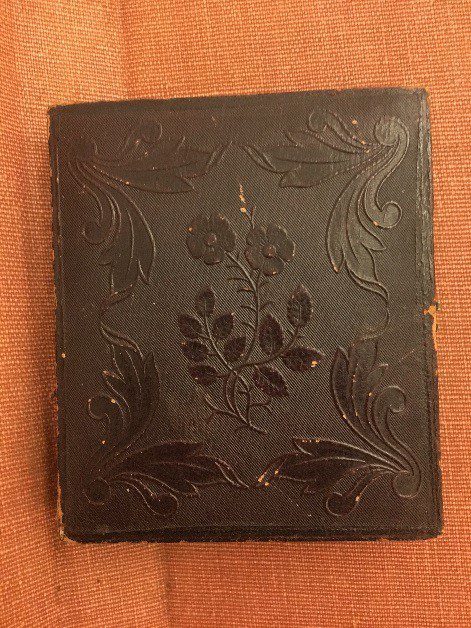
While research concluded that Mary Pillsbury Weston was not the creator of the Weston Profiles, another Mary Weston was most probably involved. The Westons produced silhouettes in the 1840s, and as the daguerreotype became more popular and more accessible to a larger market, they diversified by opening a daguerreotype studio. By the end of the decade and into the 1860s, they started to create photographs and carte-de-visites, continuing to stay abreast of consumer demands. They did not garner the notoriety like famous daguerreotypists Matthew Brady or Jeremiah Gurney, nor did they operate on their scale. In fact, New York City was filled with studios like the Westons’. In 1853, it was estimated that there were 86 portrait galleries in the city. (7) More research needs to be conducted on these smaller enterprises to get a better sense of the operations of a portrait-making and -selling business like the Westons’, and its relationship to a larger network of material production in mid-19th-century New York. You can see this silhouette and others from the Winterthur Library and museum collection in the special loan exhibition In Fine Form: The Striking Silhouette at the Delaware Antiques Show, November 9–11, 2018. Post by Amanda Hinckle, 2017-2018 Robert and Elizabeth Owens Curatorial Fellow, Museum Collections Department, Winterthur Museum, Garden & Library Winterthur is very grateful for funding from the National Endowment for the Arts, which has given us the ability to photograph and digitize works on paper in the collection, including these silhouettes. (1) Northeast Auctions. Fall Weekend Auction, October 31-November 1, 2015.Portsmouth, NH: 2015. Auction Catalog. https://northeastauctions.com/product/mary-pillsbury-weston-american-1817-1894-full-length-silhouette-of-a-woman-circa-1840/ (2) Emma Rutherford, Silhouette: The Art of the Shadow (New York: Rizzoli, 2009). (3) J Winchester, “Daguerreotype Portraits,” The New World: A Weekly Journal 5 (November 26, 1842): 351. (4) Although not in the New York City directories until 1848, the arrival of a Robert Weston is reported in the New-York Spectator in 1837, which is backed by immigration records. “Passengers,” New-York Spectator, March 28, 1837. (5) Craig’s Daguerreian Registry, last modified 1998, http://craigcamera.com/dag/. (6) New York Daily Herald, March 17, 1866, 7. (7) Ethan Robey’s dissertation titled “The Utility of Art: Mechanics’ Institute Fairs in New York City, 1828-1876,” includes an appendix listing artists who displayed their work. Ethan Robey, “The Utility of Art: Mechanics’ Institute Fairs in New York City, 1828-1876” PhD diss., Columbia University, New York, 2000. (8) Beaumont Newhall, The Daguerreotype in America, 3rd ed. (New York: Dover, 1976), 55.
Goats of Winterthur
This article was written in June 2017 by Natural Lands Intern Caroline Toth. Sadly, one of the goats that she portrays, Stanley, passed away at the end of August. This wonderful blog post offers not only a joyful glimpse into a little known world at Winterthur, but also timely solace to those of us saddened by the loss of a much-loved four-footed friend. Thank you, Carrie, for providing both.
As the weather warms and the meadow grasses flower, Winterthur’s herd of seven Boer goats is set to work munching areas of Brown’s Woods where invasive shrub-layer plants have taken over. Although our goats can’t discern between native versus non-native plants, the act of defoliation and damage to the non-natives suppresses the populations’ reproductive success. Plus, judging by our goats’ zealous appetites, it would seem that these greens are quite the delicacy, indeed!
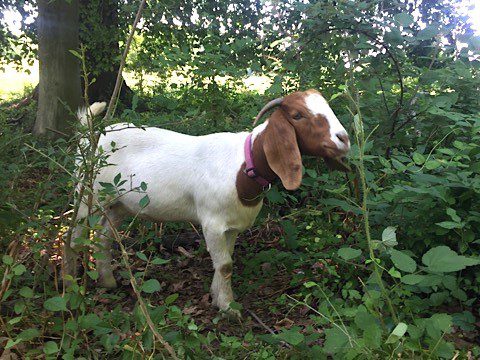
It’s not always easy to get goats to do what you want, especially when you are introducing them to something unknown. When our livestock first saw the contraption we devised to transport them from pasture to forest, they harbored some serious reservations. Luckily for us, a mere handful of treats was compensation enough for them to voluntarily enter the cage strapped on to the trailer.
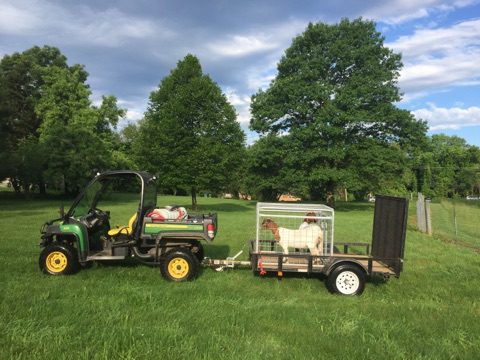
The “Who’s Who” of the Small Ruminant World All seven of our goats are purebred Boer goats. Originally from South Africa, the Boer goat was bred to be as large as possible to maximize profits in the meat market. “The bigger, the better” was the idea behind breeding Boers. Here at Winterthur, our Boers were all given to us as donations from herd owners who loved the goat in question so much that they could not bear to send them to market – and we are so glad, because now, we can’t imagine life without them!
Our first goats were Franklin and Stanley. Stanley is the alpha goat – kind of the wise caretaker of the herd. Franklin came from the same herd as Stanley, but Franklin is as loud as Stanley is quiet! Franklin is determined to make his presence known to every person and animal in the visual vicinity. When he is feeling affectionate, he lets you know by way of rubbing his head on you. When he is annoyed with you, he’ll emit a high-pitched whinny of frustration before slowly clopping away.
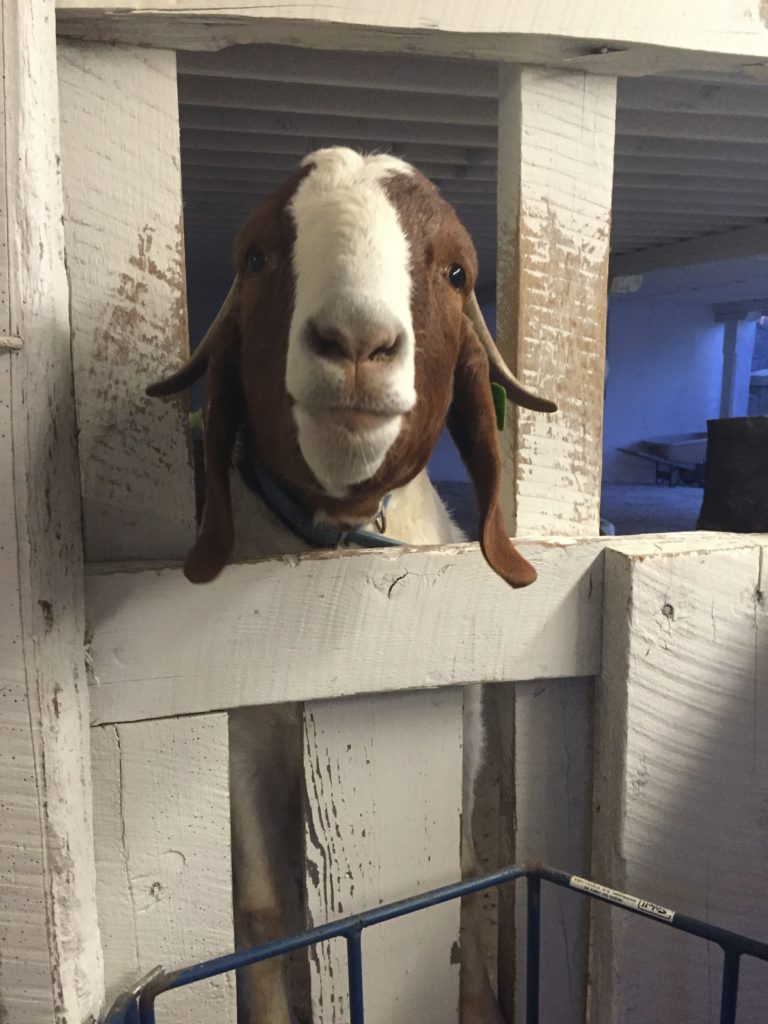
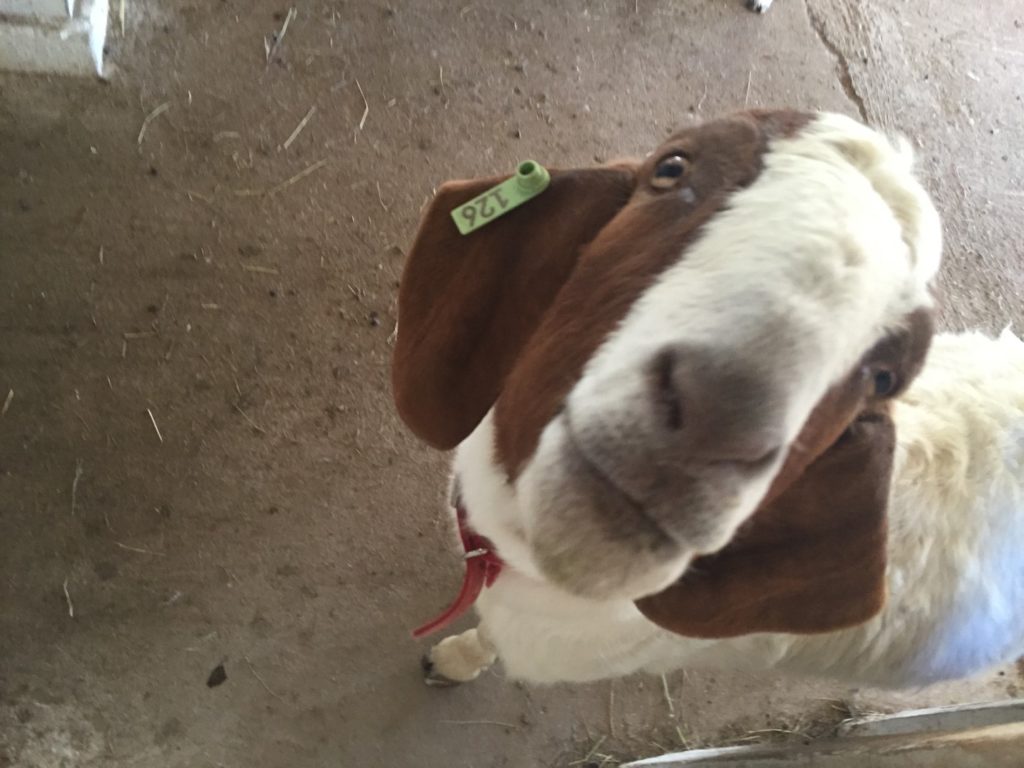
Morgan is a former show goat. Although she was born and raised on a meat farm, her good looks saved her from going to market. When she was pregnant with her kids, however, she developed a sway back. Around that same time, the tag on her left ear became stuck in a fence, and she ripped herself free, resulting in a permanently ripped ear. Because show goats are expected to be physically perfect, Morgan’s looks weren’t enough to save her anymore. We are lucky, then, that she had her babies Minnie and Missie. When Morgan’s previous owner saw how sweet they all were together, she donated the three of them to Winterthur to spare them a life of hardship.
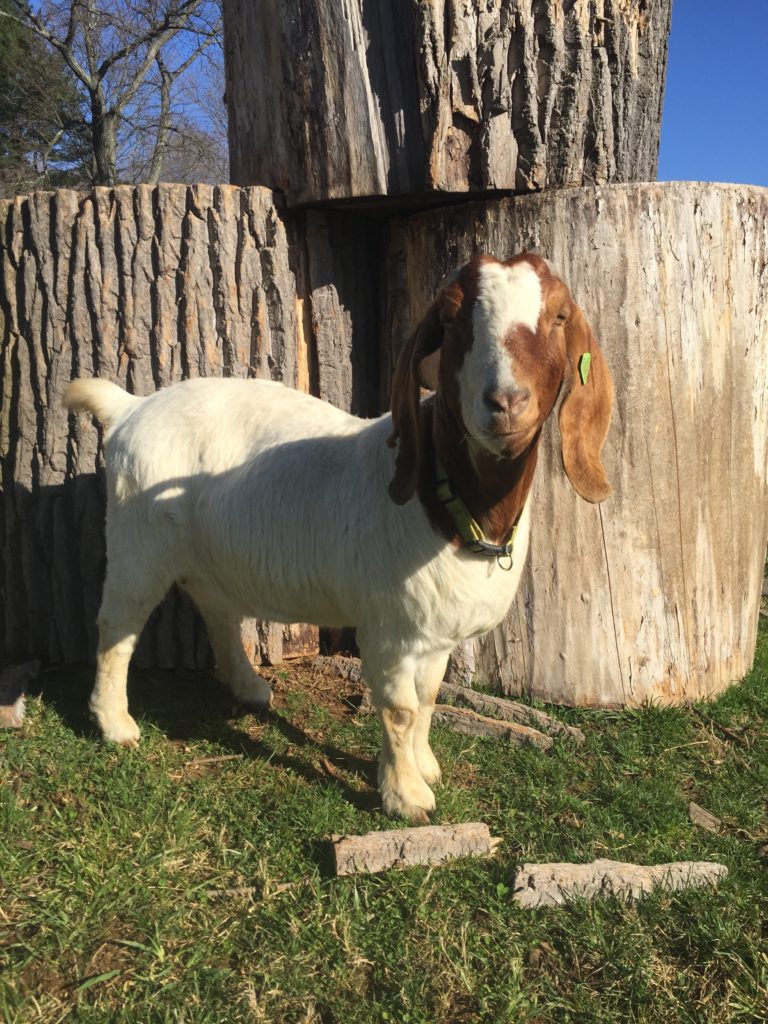
Minnie and Missie are twins. They are now one year old – old enough to fend for themselves, in goat culture. But up until April, Morgan defended her kids with her life. She fiercely attacked any goat who came too close to her precious babies, and every human who came near was put under immediate scrutiny. Due to living such sheltered lives, Minnie and Missie developed exceptionally playful and affectionate attitudes. Although they now each fend for themselves, they still maintain the sweet and mischievous affectation they were notorious for when they were babies.
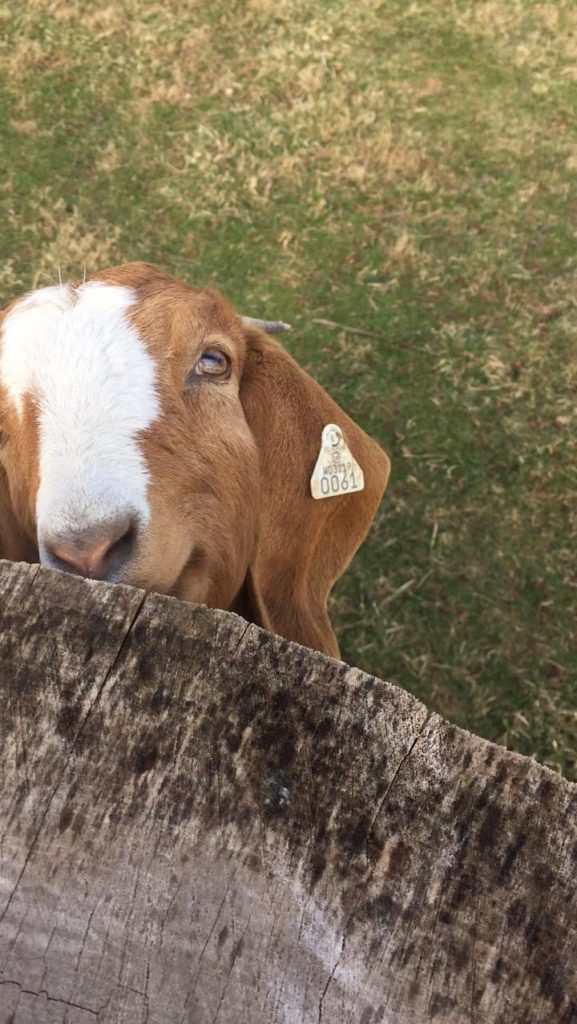
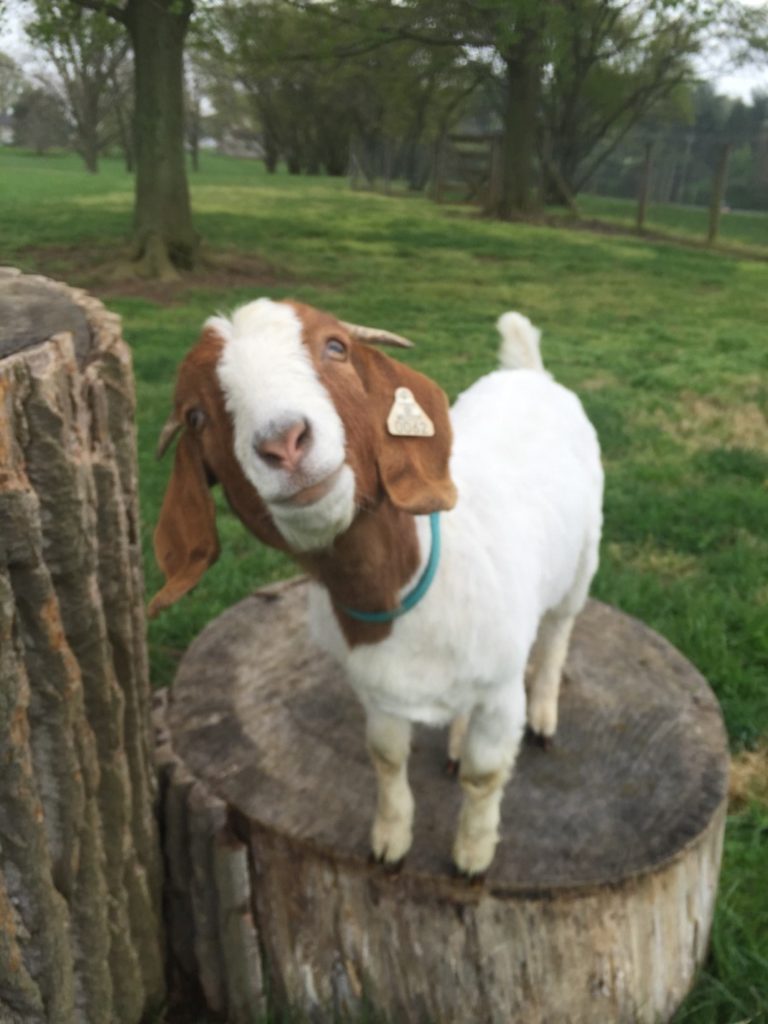
Nora and Riley are half-sisters who came from the same farm. Although they had different mothers, they were born around the same time. As kids, they bonded closely when both of them were donated to Winterthur in 2016. They are each fourteen months old – only two months older than Minnie and Missie – but they didn’t have their mothers around to protect them when they were smaller. Because of this, they had to learn to fend for themselves at an early age. Even though life is much more pleasant for them now, a youth of hardship instilled in them a quiet cleverness that still manifests itself every day.
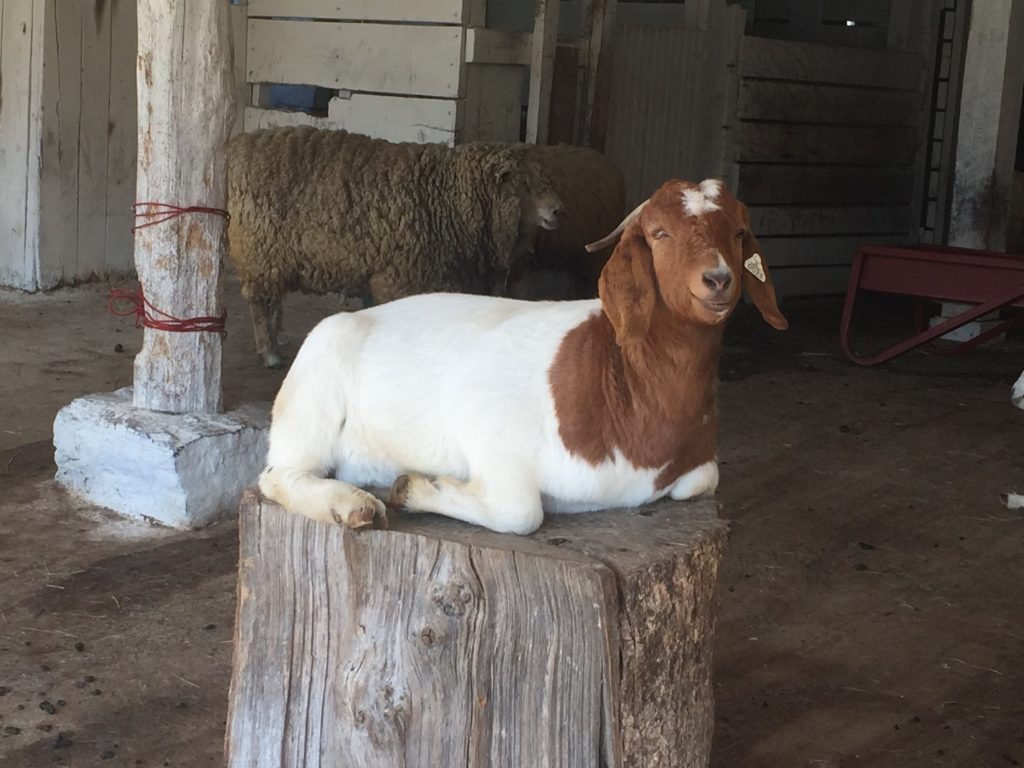
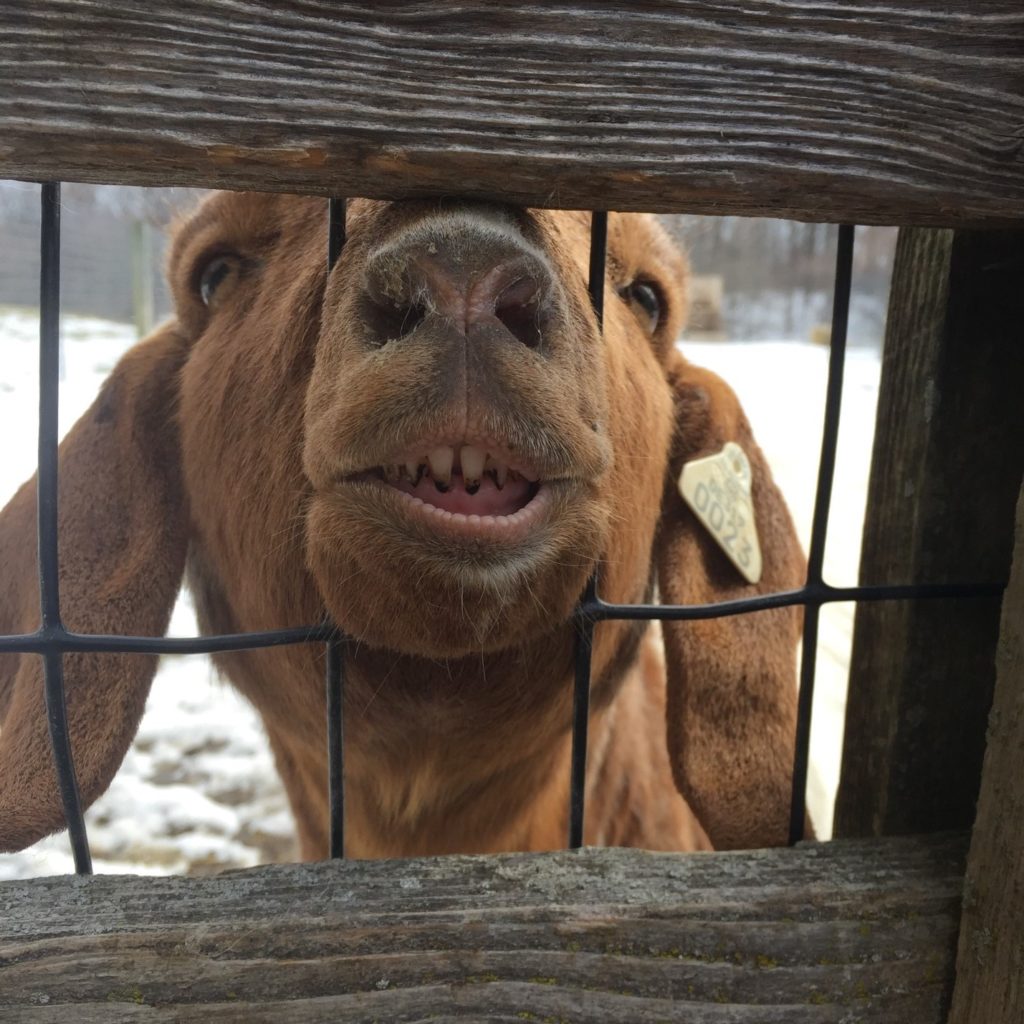
It’s been a privilege introducing you to Winterthur’s goats! Just one glimpse of these creatures, whether out in the fields grazing or sitting atop their jungle-gym of giant tree stumps, will likely be one of the happiest sights you will see at Winterthur!
